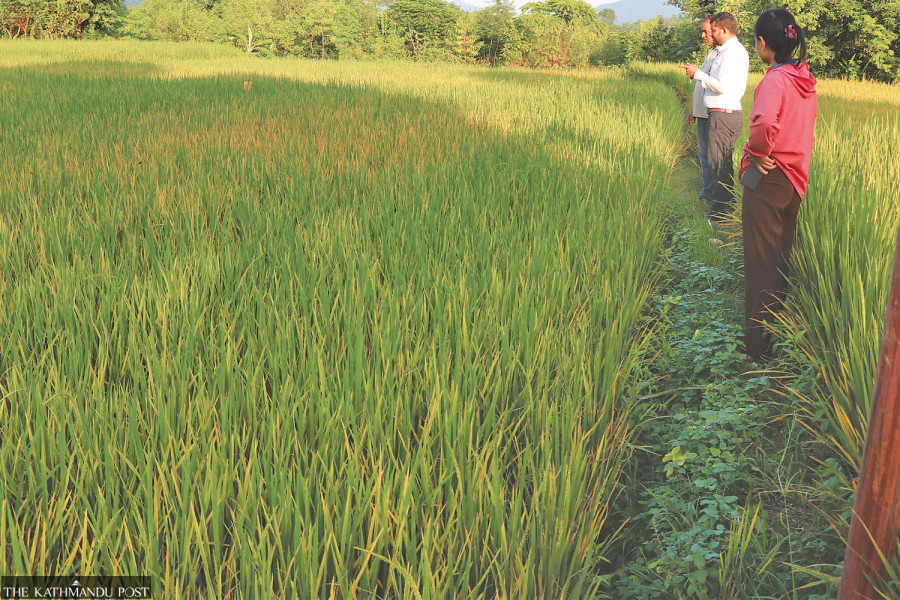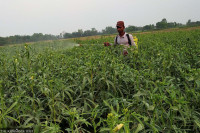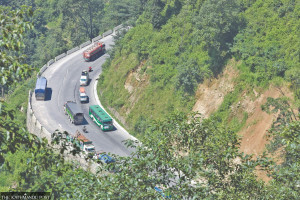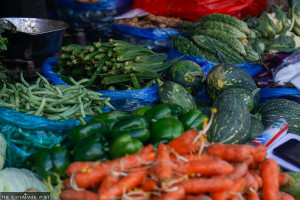Money
Whitefly outbreak affects hectares of paddy in Palpa
In places like Rampur, Nisdi, Madi and Tinau, the district’s food baskets, farmers are worried about their income this year.
Madhav Aryal
Whiteflies have affected more than 100 hectares of paddy fields in Palpa, in western Nepal, reducing the crop yield by two thirds.
The whiteflies (Aleurocybotus indicus) have been affecting the crop since August.
In many parts of Palpa, like Rampur, Nisdi, Madi, and Tinau, the district's food basket, farmers are worried about their income this year.
Yubaraj Adhikari, a farmer of Rampur Municipality, said his paddy, planted on 0.5 hectares, has been severely affected. "The plant turned red from green."
He said the flies had attacked the paddy during the flowering stage, which means the plants still stand but will not bear kernels.
A typical rice kernel is 6–10 mm long. Farmers say rice kernel will be halved even in some areas where there is some recovery.
"Based on the plant's growth, I initially expected to harvest 2 tonnes of rice. Now, it is difficult to expect even 500 kilograms."
Farmers said hectares of rice were affected—about 70 percent potentially damaged.
The government authority, however, said they are yet to do the damage assessment.
Adults are tiny (about 1 to 1.5 mm) white-winged insects. The wings cover the entire body. A single whitefly can lay up to 200 eggs; if not promptly addressed, the rice will turn reddish about a week after the eggs are laid.
Palpa has been witnessing a series of pest attacks, which experts say may be due to the change in the climate pattern.
According to the National Climate Change Survey 2022, released by the National Statistics Office, formerly the Central Bureau of Statistics, in May, over the past 25 years, approximately 50 percent of households surveyed reported the emergence of new diseases in their crops.
Similarly, 53.9 percent observed the presence of new insects or pests affecting their crops, and 29.8 percent of households noted the appearance of new diseases in their livestock.
Agriculture is the mainstay of Nepal's economy. It contributes 24.6 percent to the country's GDP and employs over half of its population.
In Palpa, three years ago, an insect known as hopper—plant feeders that suck plant sap from grass, shrubs or trees—infected a large swathe of farmland in Madi, Rampur, Argali and Kachal.
Shanti Dotel of Rampur municipality has no hopes of making income from the paddy this year.
“The whiteflies have attacked the paddy field. It has turned red," she said.
Madi and Tinau are the most affected areas.
Yam Bahadur Chidi, chairman of Mathagadi rural municipality, said they had received complaints from farmers about the crop damage. "The pest attacked the crop during the flowering period, which will significantly affect the output."
"The yield will drop," said Mani Ram Adhikari, another farmer of Rampur Municipality-6.
Farmers said that among several varieties, the high-yielding Sabitri is mainly affected by whiteflies.
Rampur has been affected by the whiteflies for the last three years, and the flies are gradually invading other areas.
The municipality said that whiteflies have been reported since August, mainly in four wards—4, 5, 6 and 7.
The municipality even launched a pesticide spray programme, but to no avail.
Shanti Dotel, a farmer of Rampur municipality-6, said she chose to plant an improved variety of paddy to get a larger yield, but the situation changed. "It looks like the straw will also not work."
She said the pest attack was mostly seen on the hybrid varieties and nominally affected the local varieties.
"It has mostly affected the variety Sabitri," said Narayan Prasad Gaire, chief of the agriculture section of Rampur Municipality. “We have even distributed pesticides to the farmers. In some places, we have observed some regeneration in plants."
Palpa has 8,210 hectares of paddy fields, and hybrid types have been proliferating.




 18.12°C Kathmandu
18.12°C Kathmandu














